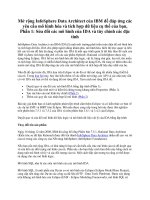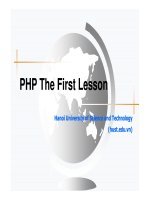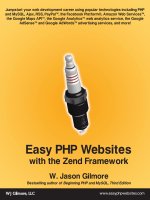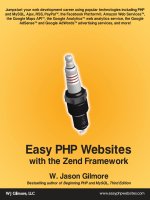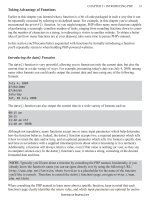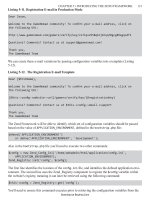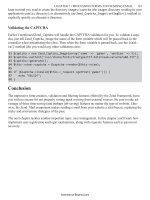Easy PHP Websites with the Zend Framework (phần 1) pot
Bạn đang xem bản rút gọn của tài liệu. Xem và tải ngay bản đầy đủ của tài liệu tại đây (1.86 MB, 50 trang )
Jumpstart your web development career using popular technologies including PHP
and MySQL, Ajax, RSS, PayPal™, the Facebook Platform®, Amazon Web Services™,
the Google Maps API™, the Google Analytics™ web analytics service, the Google
AdSense™ and Google AdWords™ advertising services, and more!
Easy PHP Websites
with the Zend Framework
W. Jason Gilmore
Bestselling author of Beginning PHP and MySQL, Third Edition
WJ Gilmore, LLC
www.easyphpwebsites.com
Download at Boykma.Com
Easy PHP Websites
with the Zend Framework
W. Jason Gilmore
Download at Boykma.Com
Easy PHP Websites with the Zend Framework
Copyright © 2009 W. Jason Gilmore
Published by
W.J. Gilmore, LLC
1373 Grandview Avenue, Suite 214
Columbus, Ohio 43212
All rights reserved. No part of this publication may be reproduced or transmitted in any form or by
any means, electronic, mechanical, photocopying, scanning, recording or otherwise, except as permit-
ted under the 1976 United States Copyright Act, without the prior written permission of the copyright
owner and the publisher.
Trademarks: Trademarked names may appear in this book. Rather than use a trademark symbol with
every occurrence of a trademarked name, we use the names only in an editorial fashion and to no ben-
et of the trademark owner, with no intention of infringement of the trademark. Zend is a trademark
of Zend Technologies Ltd. Amazon Web Services™ is a trademark of Amazon.com, Inc. Facebook®
is a registered trademark of Facebook Inc. PayPal® is a registered trademark of PayPal, Inc. Google
Maps API™, GoogleAdSense™, and Google AdWords™ are trademarks of Google Inc. All other
trademarks are the property of their respective owners. W.J. Gilmore, LLC is not associated with any
product or vendor mentioned in this book.
Limit of Liability: The information in this book is distributed on an "as is" basis, without warranty.
Although every precaution has been taken in the preparation of this work, neither the author(s) nor
W.J. Gilmore, LLC shall have any liability to any person or entity with respect to any loss or damage
caused or alleged to be caused directly or indirectly by the information contained in this work.
Source Code: The source code for this book is available at />Download at Boykma.Com
Dedicated to my family
Download at Boykma.Com
Download at Boykma.Com
Table of Contents
CHAPTER 1. Conguring Your Development Environment 1
CHAPTER 2. Introducing PHP 23
CHAPTER 3. Interacting With Your Users 51
CHAPTER 4. Introducing MySQL 75
CHAPTER 5. Introducing the Zend Framework 105
CHAPTER 6. Talking to the Database with Zend_Db 137
CHAPTER 7. Processing Forms and Sending Email 161
CHAPTER 8. Managing Your User Community 183
CHAPTER 9. Integrating Google Maps 211
CHAPTER 10. Introducing the Amazon Associates Web Service 231
CHAPTER 11. Enhancing the User Interface with Ajax 245
CHAPTER 12. Extend Your Website with RSS and Facebook 263
CHAPTER 13. Monitor Trafc and Manage Ads with Google 287
CHAPTER 14. Accepting Online Payments with PayPal 305
CHAPTER 15. Introducing Zend_Tool 315
Download at Boykma.Com
Expanded Table of Contents
CHAPTER 1. Conguring Your Development Environment 1
Step #1. Installing Apache, MySQL, and PHP on Windows 2
Step #2. Testing Your Installation 13
Step #3: Choosing a Code Editor 14
Step #4. Exploring Other Useful Software 17
Step #5. Choosing a Web Hosting Provider 19
CHAPTER 2. Introducing PHP 23
Step #1. Creating Your First PHP-Enabled Web Page 23
Step #2. Publishing Spreadsheet Data to the Web 38
Displaying Data in a Table 41
Step #3. Managing Your Site Design Using Templates 47
CHAPTER 3. Interacting With Your Users 51
Step #1. Creating a Contact Form 52
Step #2. Validating User Input 56
Step #3. Repopulating Form Data 65
Step #4. Sending Form Data via E-mail 67
Step #5. More on Securing User Input 72
CHAPTER 4. Introducing MySQL 75
Step #1. What Is a Relational Database? 76
Step #2. Introducing MySQL 77
Step #3. Introducing phpMyAdmin 83
Step #4. Moving Your Data to MySQL 86
Step #5. Connecting Your Website to MySQL 88
Step #6. Restricting Access 103
CHAPTER 5. Introducing the Zend Framework 105
Step #1. What Is a Web Framework? 106
Step #2. Introducing the Zend Framework 112
Step #3. Installing the Zend Framework 115
Step #4. Testing Your Installation 121
Step #6. Creating the Website Layout 125
Download at Boykma.Com
Step #7. Creating a Conguration File 130
Step #8. The init() Method 133
Step #9. Creating Action Helpers 133
CHAPTER 6. Talking to the Database with Zend_Db 137
Step #1. Introducing Object-relational Mapping 138
Step #2. Introducing Zend_Db 139
Step #3. Creating Your First Model 140
Step #4. Querying Your Models 141
Step #5. Creating a Row Model 145
Step #6. Inserting, Updating, and Deleting Data 146
Step #7. Modeling Table Relationships 148
Step #8. JOINing Your Data 151
Step #9. Paginating Results with Zend_Paginator 155
Step #10. Creating and Managing Views 157
CHAPTER 7. Processing Forms and Sending Email 161
Step #1. Zend Framework Forms Fundamentals 162
Step #2. Creating the GameNomad Contact Form 163
Step #3. Validating Form Data 166
Step #5. Filtering Form Data 177
Step #6. Preventing Spamming Using CAPTCHAs 178
CHAPTER 8. Managing Your User Community 183
Step #1. Creating the Users Table and Model 184
Step #2. Registering Users 188
Step #4. Displaying User Proles 203
CHAPTER 9. Integrating Google Maps 211
Step #1. Introducing the Google Maps API 212
Step #2. Adding Mapping Services to Your Website 223
CHAPTER 10. Introducing the Amazon Associates Web Service 231
Step #1. Introducing the Amazon Associates Web Service 232
Step #2. Introducing the Zend_Service_Amazon Component 234
Download at Boykma.Com
Step #3. Searching for Products 239
Step #4. Customer Reviews 241
CHAPTER 11. Enhancing the User Interface with Ajax 245
Step #1. Introducing JavaScript 246
Step #2. Introducing Ajax 261
CHAPTER 12. Extend Your Website with RSS and Facebook 263
Step #1. Building and Publishing RSS Feeds 264
Step #2. Introducing the Facebook Platform 269
Step #3. Building Your First Facebook Application 274
Step #4. Introducing the Facebook PHP Client Library 276
Step #5. Creating a Facebook Platform Controller 277
Step #6. Creating a Facebook Prole Tab 280
Step #7. Sending a Facebook User Notication 282
Step #8. Adding Facebook Status Updates 283
Step #9. Deploying Your Facebook Application 285
CHAPTER 13. Monitor Trafc and Manage Ads with Google 287
Step #1: Monitoring Trafc with Google Analytics 287
Step #2. Advertising with Google AdWords 294
Step #3: Earning Money with Google AdSense 301
CHAPTER 14. Accepting Online Payments with PayPal 305
Step #1. Integrating PayPal Website Payments Standard 305
Step #2. Exploring Third-Party E-Commerce Solutions 309
CHAPTER 15. Introducing Zend_Tool 315
Step #1. Conguring Zend_Tool 315
Step #2. Creating and Managing Projects with Zend_Tool 316
Download at Boykma.Com
Download at Boykma.Com
Download at Boykma.Com
About the Author
Jason Gilmore is founder of W.J. Gilmore LLC ( a publishing and
consulting rm based out of Columbus, Ohio. Formerly Apress' open source editor, Jason fostered the
development of more than 60 books, along the way helping to transform their open source line into
one of the industry’s most respected publishing programs.
Jason is the author of several books, including the bestselling Beginning PHP and MySQL: From
Novice to Professional (currently in its third edition), Beginning PHP and PostgreSQL: From Nov-
ice to Professional, and Beginning PHP and Oracle: From Novice to Professional. He has over 100
articles to his credit within prominent publications such as Developer.com, Linux Magazine, and
TechTarget.
Jason is a cofounder of CodeMash (
a nonprot organization tasked
with hosting an annual namesake developer’s conference, and was a member of the 2008 MySQL
Conference speaker selection board.
Download at Boykma.Com
About the Technical Reviewer
Chris J. Davis is a Senior Web Developer and Mac enthusiast living in North Texas. He is an inter-
national speaker on the intersection of technology and community as well as a founder of the Habari
Project, a next generation publishing platform. Also a published author, Chris coauthored Blog Design
Solutions from Friends of Ed.
Recently Chris has been invited to become a committer on the Apache Software Foundation Infra-
structure team, which he enthusiastically accepted. You can nd more out about Chris by visiting
his website () or by following him on Twitter
( />Download at Boykma.Com
Acknowledgements
Ernest Hemingway once offered a particularly sober assessment of his trade, saying, "There is noth-
ing to writing. All you do is sit down at a typewriter and bleed." This being my fth book, and the
rst published under my eponymous press, W.J. Gilmore LLC, I can sympathize with his appraisal.
Thankfully, psychological rst aid is readily available from the family, friends, and colleagues who
always make this process much less painful.
Chris Davis did an excellent job as a tech reviewer, catching numerous mistakes made as I fought
with both code and prose.
Carlene DeFiore helped out immensely, reviewing chapters, helping with promotional strategy, and
keeping me well fed.
Countless other individuals played key advisory roles in helping this book to nally see the light. In
alphabetical order, they include David Futato, Jonathan Hassell, Stu Johnson, and Matt Zenko. I'd
also like to thank the great people at the Grandview Heights Fifth Third Bank and U.S. Post Ofce for
helping get the business off the ground.
I'd perhaps never have gotten into the publishing business without the help of Apress cofounder Gary
Cornell, who rst contacted me back in 2000 to write a book for what was then a very small but dar-
ing computer book upstart (one which has since grown into a rather large but still daring publisher).
He played a pivotal role in my development as an author and later an editor for Apress. Thank you
Gary.
Last but certainly not least, I'd like to thank you dear reader, for having enough faith to trade your
hard-earned money for this book.
Download at Boykma.Com
Introduction
Picture spending an evening hanging out with a group of gregarious savants from around the globe.
Over hors d'oeuvres you debate the merits of globalism, and split time during dinner extolling the
ferocity of the 2008 Pittsburgh Steelers defense and listening intently to two physicists argue over the
plausibility of time travel. The evening concludes with no less than four renditions of Beethoven's
Symphony no. 7, including electronica and hip-hop versions. No doubt, an evening such as this would
leave even the most tempered of socialites admitting to being among raried company. This also hap-
pens to be an evening any one of us could spend while surng the World Wide Web.
We're living in the midst of the most prolic democratization of knowledge in the history of the
world. In the twenty years since Tim Berners-Lee's authoring of the paper which led to the creation of
the World Wide Web, we've progressed from a civilization dependent upon the often meager resourc-
es of small town libraries and yellow journalism of local media outlets to one which has practically
all of the information in the history of the world available at the cost of just a few keystrokes. Never
mind that most users tend to use this profound invention to keep up with Hollywood gossip.
Of course, the Web is enormously successful because it’s a two way street. That is, it's just as easy to
read up on a history of the Napoleonic campaigns as it is to create your own website on the topic. And
with the proliferation of powerful programming languages and frameworks such as PHP and the Zend
Framework, and the ability to plug into enormous databases via services such as Amazon Associates
and Google Maps API, your ambition is limited only by your creativity and understanding of how
these tools work. While you're on your own to address the former requisite, I hope this book goes a
long way towards satisfying the latter by showing you how to push these tools to their very limits.
Intended Audience
Whether you're a serial entrepreneur, a hobbyist wishing to use the Web to introduce others to your
pastime, or a project manager simply wishing to understand more about exactly what it is your IT-
minded colleagues do during the day, this book is for you. I make no presumptions regarding the
reader's level of programming knowledge, beginning at a logical starting point and gradually intro-
ducing new concepts accompanied by plenty of examples.
Likewise, if you're a seasoned PHP programmer wishing to learn more about the Zend Framework
to build powerful websites in conjunction with popular technologies such as the Amazon Associates
Web Service, Google Maps API, RSS, Facebook, and PayPal, you may wish to simply skip the four
introductory chapters and jump right into the more advanced chapters.
About the Book
When I wrote the bestselling Beginning PHP and MySQL: From Novice to Professional, now in its
third edition (Apress, 2008), my goal was to produce a book that somehow measured up to the unpar-
alleled breadth of features offered by these two powerful technologies. At 1,044 pages, many would
say my objective was met, and indeed at present it remains the most voluminous book written on the
topic in the country, if not the world. If nothing else, it can hold a door open in even the most wicked
Download at Boykma.Com
of windstorms.
When I set out to write Easy PHP Websites with the Zend Framework, my strategy was decidedly
different. Rather than attempt to provide readers with a survey of every possible feature available to
PHP, the Zend Framework, and the array of other popular technologies discussed in the book, I made
a conscious effort to focus on key topics which I thought would be of most benet to the time- and
resource-challenged reader who was looking to maximize his every second spent working towards
the goal of building a powerful website. Accordingly, each chapter is devoted to accomplishing a very
specic, desired task, such as processing payments with PayPal, building a Facebook application,
integrating Google Maps into a website, and building a product catalog using the Amazon Associates
Web Service. You'll also gain from practical instruction on topics pertinent to the logistical-side of
Web development, such as creating an ideal development environment, what to keep in mind when
choosing a web hosting provider, and how to take advantage of services such as Google Analytics,
Google AdWords, and Google AdSense.
In an attempt to keep the instruction topical and applicable to current trends, the book guides you
through the hypothetical creation of a social networking website for video game enthusiasts. You'll
start simple, learning how to convert a spreadsheet used to track your video game collection into a
format capable of being viewed via the Web. From there the project builds in ambition, migrating the
collection to a MySQL database, and subsequently turning to the popular Zend Framework in order to
more effectively manage user accounts, process data submitted via Web forms, and send e-mail. The
nal six chapters show you how to integrate the Zend Framework with popular third-party services
such as Google Maps, Amazon.com, Facebook, and PayPal to build an even more compelling web-
site. Of course, you're free to pick-and-choose among these topics, using the chapters what you nd
most appealing and disregarding the rest.
Incidentally, the video game theme wasn't altogether contrived. My own interest in video games led
to the creation of GameNomad (
a social networking website which
gives gamers and their like-minded friends tools for managing their respective game collections.
Quite a bit of the code and many examples are based on the website, and in fact you'll nd quite a bit
of the code used to power the GameNomad website within the source code download.
Book Contents
Easy PHP Websites with the Zend Framework is broken into fourteen chapters, and supplemented
with several videos available to readers via the website
/>Chapter 1. Conguring Your Development Environment
In this introductory chapter you'll learn how to create the ultimate development environment. In addi-
tion to showing you how to install Apache, PHP and MySQL on Windows XP and Vista, you'll learn
about useful development tools such as Eclipse PDT, Freemind, and the Firefox Developer Add-on.
We'll also discuss the different types of hosting providers, and what to keep in mind when selecting a
provider.
Chapter 2. Introducing PHP
With the development environment in place, it's time to start coding! In this chapter you'll be intro-
duced to PHP's fundamental syntax, setting the stage for publishing your rst dynamic web page.
Download at Boykma.Com
Rather than guide you through a bunch of contrived examples, you'll instead learn how to do some-
thing useful: migrating an Excel spreadsheet to the Web! You'll also learn how to effectively manage
your website design by using a simple but effective approach.
Chapter 3. Interacting with Your Users
The beauty of the web is that it's a two-way street; not only can you disseminate information to inter-
ested visitors, but so can your visitors provide feedback and interact in a variety of ways. The most
commonplace way to do so is via a web form. In this chapter we'll cover form fundamentals, teach-
ing you not only how to retrieve data submitted through a form, but also validate the data to ensure it
meets your expectations. You'll also learn how to send this form data directly to your inbox by send-
ing an e-mail directly from a PHP script.
Chapter 4. Introducing MySQL
As your website ambitions grow, so will your need to devise a way to effectively manage data. The
most commonplace way for doing so is using a relational database. In this chapter I'll introduce you to
MySQL, one of the most popular such databases in the world.
Chapter 5. Introducing the Zend Framework
Building a successful website is a product of much more than mere programming. You need to deal
with an enormous number of factors, including conguration issues such as creating user-friendly
URLs and managing site conguration data, security issues such as validating user input and prevent-
ing other commonplace attacks, user interface issues such as managing design templates and adding
Ajax features, and integrating third-party services. Because all web developers face similar issues,
web frameworks were created to handle many of these gory details for you. Once such framework is
the popular PHP-driven Zend Framework, and this chapter introduces this impressive solution.
Chapter 6. Talking to the Database with Zend_Db
Chapter 4 showed you how to write queries which PHP which made it possible to interact with a
MySQL database. Although unquestionably useful, if you're like me there was something oddly un-
natural about mixing PHP and SQL code together within a single script. In this chapter I'll show you
how to have your cake and eat it too by using the Zend_Db component to interact with MySQL using
purely PHP code.
Chapter 7. Processing Forms and Sending Email
This chapter extends what was learned in Chapter 3, using the Zend Framework to process user-sub-
mitted data. You'll also learn about the Zend Framework's powerful built-in data validation and lter-
ing features, how to send e-mail using the Zend_Mail component, and how to foil spammer activity
using a mechanism known as a CAPTCHA.
Chapter 8. Managing Your User Community
These days, a successful web-based venture is often the direct result of your ability to create a suc-
cessful online community. In this chapter you'll learn how to build fundamental community mecha-
nisms such as user registration, user login and logout, password recovery, user prole display, and
connecting users via a simple social networking mechanism.
Chapter 9. Integrating Google Maps
Google's release of an interface to the popular Google Maps mapping solution opened the oodgates
for thousands of location-based websites. In this chapter you'll learn how to use this API to integrate
Download at Boykma.Com
Google's mapping features into your own website. You'll also learn how to use the Google Geocoder
to convert user's mailing addresses into latitudinal and longitudinal coordinates.
Chapter 10. Introducing Amazon Associates Web Service
The Amazon Associates Web Service (AWS) offers developers around the globe with a great way to
earn revenue by advertising Amazon's product catalog in new and interesting ways. In this chapter
you'll learn how to take advantage of this program to create your own custom catalog. You'll also
learn how to retrieve Amazon reviews for a particular product, and even how to use a neat Zend
Framework view helper feature to tie a visually appealing starred effect to each review.
Chapter 11. Enhancing the User Interface with Ajax
Enhancing the user experience by enhancing the interface is all the rage these days, a process most
commonly done using JavaScript and a programming technique known as Ajax. In this chapter I'll
introduce you to both JavaScript and Ajax, alongside the popular Prototype JavaScript framework and
Scriptaculous libraries.
Chapter 12. Extend Your Website with RSS and Facebook
Today's users expect to be able to consume information in a format and at a time convenient to them,
whether it be via email, a news aggregator such as Google Reader, or even via another website alto-
gether such as Facebook. Much of the information assembled in this digestible manner comes by way
of RSS feeds, a convenient markup format similar to HTML which is conducive to publishing website
updates and other information in digest format. In this chapter you'll learn how to publish your own
feeds using the Zend Framework's Zend_Feed component.
You'll also learn how to create a Facebook application using the Facebook Platform. Creating a Face-
book application is easier than you think, and has the potential to introduce your website to millions
of new users.
Chapter 13. Monitor Trafc and Managing Ads with Google
Putting countless hours into your website is somewhat fruitless if you lack the ability to closely track
visitor trafc and demographics. Thankfully, doing so is a breeze using the Google Analytics web
analytics service. In this chapter you'll learn how to congure this free service for use on your own
website. You'll also learn how to spread the word about your website using the world's most popular
online advertising network, namely the Google AdWords advertising program. While you're at it,
why not earn some advertising revenue by publishing ads on your website using the Google AdSense
advertising program, another topic discussed in this chapter.
Chapter 14. Accepting Online Payments with PayPal
In this chapter, we'll discuss e-commerce transactions using PayPal Checkout, which is one of the
world's most popular services for accepting online payments. For those readers who require a some-
what more sophisticated e-commerce solution, we'll close the chapter with an overview of three
popular e-commerce solutions.
Chapter 15. Introducing Zend_Tool
In the nal chapter of the book, you’ll learn about the new Zend_Tool component, a command-line
utility which will make creating new Zend Framework-driven applications a breeze.
Download at Boykma.Com
Downloading the Source Code
The source code for this book is available via the website />Contact the Author
Over the past decade I've responded to thousands of reader e-mails, and eagerly look forward to
responding to yours. E-mail me at with your questions and comments
regarding this book, or anything else that strikes your fancy.
Download at Boykma.Com
CHAPTER 1
Conguring Your Development Environment
Chances are you'll be relying on a web hosting provider to manage your website, however for reason
of convenience and efciency you'll want to develop the website on a personal workstation or laptop.
In this chapter I'll show you how to install Apache, PHP and MySQL on the Windows XP and Win-
dows Vista operating systems. You'll also be introduced to several integrated development environ-
ments (IDEs) and other utilities which will prove invaluable when building your web applications, as
well as become acquainted with the issues you'll need to keep in mind when selecting a web hosting
provider.
VIDEO. Introducing PHP and MySQL
Just what makes the PHP language and MySQL database so popular? Why are they so com-
monly used together to build websites both large and small? This video introduces you to
PHP and MySQL, focusing on the features which have turned open source projects with
modest beginnings into two of the world's game-changing technologies. Watch the video at
/>Chapter Steps
The goals of this chapter are accomplished in ve steps:
• Step #1. Installing Apache, MySQL and PHP on Windows: In this step you'll learn how
to install Apache, PHP and MySQL both the easy way (using an automated installer called
XAMPP) and the hard way (manually) on the Windows XP or Vista operating systems.
Special attention is paid to troubleshooting confusing installation and conguration issues on
the Windows platform. Don't worry if your laptop or computer is a few years old, because the
software can run quite ably with minimal resources.
• Step #2. Testing Your Installation: In this step you'll test your installation by creating your
rst PHP script. Although the next chapter is devoted to acquainting you with PHP syntax, in
this chapter you'll learn how to embed PHP into a web page and make it available for request
via the web server.
• Step #3. Choosing a Code Editor: Creating PHP programs doesn't require special develop-
ment tools; in fact you could write working PHP code with a text editor as simple as Notepad
if you'd like. However, there are numerous code editors suited specically for PHP develop-
ment which will help you to create web applications much more quickly and efciently. In
this step I'll introduce you to several of these editors
• Step #4. Exploring Other Useful Software: In addition to a code editor, you'll want to take
advantage of several other great development-related tools. In this step I'll introduce you to
some of my favorites.
• Step #5. Choosing a Web Hosting Provider: Eventually you'll want to make your website
Download at Boykma.Com
2 CHAPTER 1 • CONFIGURING YOUR DEVELOPMENT ENVIRONMENT
available to others. Most individuals and organizations rely on a web hosting provider to host
their website. In this nal step you'll learn about what factors you should keep in mind when
choosing a hosting provider.
NOTE. Linux-minded readers might be wondering why installation instructions for their favorite
distribution aren't provided in this chapter. The simple answer is that there are simply too many
distributions to cover, making any attempt to do so a largely fruitless exercise. Also, because each
major Linux distribution tends to maintain their own software repositories, chances are you already
have Apache and PHP installed!
Step #1. Installing Apache, MySQL, and PHP on Windows
In this section you'll learn about two different approaches to installing Apache, MySQL, and PHP
(hereafter referred to as AMP when collectively discussing all three) on Windows. The rst presents
the easiest solution, involving an automated installer called XAMPP. The second solution guides
you through the manual installation of AMP in three separate steps. I recommend the latter approach
because it will no doubt give you a much better technical understanding of how the AMP platform in-
teroperates. Regardless, I won't hold it against you for choosing the easy way out, and think you'll be
able to go a long way towards building and managing powerful websites even without this additional
installation and conguration knowledge.
Installing Apache, PHP, and MySQL: The Easy Way
Over the years, I've received perhaps hundreds, if not thousands of reader emails. The overwhelming
majority of these readers wrote with support questions specic to the problems they were encounter-
ing while installing Apache, PHP, or MySQL, or getting all three to properly communicate with one
another. It isn't that installing them is particularly difcult, but rather that if something goes wrong, it
can be difcult to troubleshoot the problem.
In response to the frustrating issues encountered by newcomers to installing this sort of software,
developers Kay Vogelgesang and Kai Seidler got together to create XAMPP, an automated solution
which installs Apache, PHP, MySQL for you. It removes all of the potential frustration occasionally
encountered when installing one or all of these applications, and is available for all major platforms,
including Windows (98, NT, 2000, 2003, XP, and Vista), Linux (known to work on Debian, man-
drake, RedHat, and SuSE), Mac OS X, and Solaris.
Installing XAMPP Lite
To install XAMPP, navigate to and click upon
the appropriate platform-specic link. In addition to Apache, MySQL, and PHP you'll see each
package comes with a variety of additional software, including an FTP server, the Webalizer trafc
analysis program, and phpMyAdmin (introduced in the later section, "Introducing phpMyAdmin"). If
you're running Windows, you have the option of foregoing the installation of this additional software
by downloading XAMPP Lite, which installs just Apache, MySQL, Perl, PHP, and phpMyAdmin. In
this section I'll show you how to install XAMPP Lite.
Download at Boykma.Com
3CHAPTER 1 • CONFIGURING YOUR DEVELOPMENT ENVIRONMENT
Once you've downloaded XAMPP Lite, double-click the downloaded le's icon to begin the extrac-
tion process. The extraction path will default to the same directory as the installer's download loca-
tion. I suggest changing this location to your
C:\ drive, as shown in Figure 1-1. A directory named
xampplite being created along that path, with Apache, PHP and MySQL along with various other
items being placed in this directory.
Figure 1-1. Extracting XAMPP Lite
Next you should navigate to the newly created directory and double-click the
setup_xampp.bat icon.
Executing this le will initiate the installation and conguration process. Upon completion, the instal-
lation window will be similar to that shown in Figure 1-2.
Figure 1-2. Notication of successful XAMPP installation
Upgrading XAMPP Lite
The various components comprising XAMPP are constantly being updated for reason of xing bugs,
adding and improving features, and resolving security issues. Accordingly, you'll likely occasionally
want to upgrade XAMPP to take advantage of these improvements. Doing so is surprisingly easy; just
delete the existing XAMPP installation directory and reinstall using the aforementioned instructions!
Don't forget to back up your existing documents before doing so, in case something goes awry!
In conclusion, keep in mind XAMPP is intended for development purposes only, and should not un-
der any circumstances be used to run a production website! This is because XAMPP is congured to
provide users with almost no obstacles in the way of experimenting with any feature of the installed
software. However the removal of these obstacles comes with similarly lowered barriers for malicious
users seeking to exploit your system or data.
With XAMPP installed, you can skip ahead to "Step #3. Choosing a Code Editor"!
Download at Boykma.Com
4 CHAPTER 1 • CONFIGURING YOUR DEVELOPMENT ENVIRONMENT
Installing Apache, MySQL, and PHP: The Hard Way
Ok, so installing AMP manually isn't exactly "the hard way". It just takes a bit more time and patience
than otherwise required when using XAMPP. With this additional investment comes a better under-
standing of how Apache, MySQL and PHP work together. Provided you carefully follow the instruc-
tions provided in this section, the process should work awlessly.
Installing Apache
To install Apache, navigate to You'll be redirected to the
Apache Software Foundation page listing the latest available versions. You're looking for the version
deemed "best available". However, you don't want to download the Win32 Source version; instead,
click on the Other les link, then click upon binaries, then win32, and nally download the re-
lease having the highest version number and having a title of Win32 Binary without crypto (no
mod_ssl) (MSI Installer). Select a location of your choosing (I usually place installers on the
desktop so I can easily sweep them into the Recycle Bin afterwards), and once downloaded, double-
click the icon to begin the installation process.
Preliminary Installation Procedures
You'll rst be greeted with a screen welcoming you to the Apache Installation Wizard. Click Next >
to continue. Next up is a screen prompting you to read and accept the Apache license. Take some time
to familiarize yourself with the license, accept the terms, and click
Next > to continue. Next you'll
be prompted to peruse the README le, which contains numerous valuable notes regarding running
Apache on Windows. Take a moment to read this text, and click Next > to continue.
Network Information
At this point you'll be prompted to provide three items of information (Figure 1-3): the server's net-
work domain, the server name, and the administrator's e-mail address. Newcomers tend to get hung
up at this stage, however the solution is simple: just input
localhost for both the network domain
and server name, and leave the administrator's e-mail address as-is.
The term
localhost is an alias for the address 127.0.0.1, which happens to be the address used to
identify the local computer. Therefore once Apache is running, any calls to http://localhost/ will
prompt the local Apache installation to respond.
Regarding the Administrator's e-mail address, in certain congurations this address is provided to
users in the case of a server error, however because I presume this Apache installation will be used for
development purposes, you and your team will be the only users interacting with the server, and it's
likely you'll know who to contact in such cases! That said, ll in any e-mail address you please.
At the conclusion of this screen, you're asked whether you'd like to install Apache as a service, mean-
ing it will start and stop automatically when Windows is booted and shutdown, respectively. This will
also congure Apache to listen on port 80, the default for web servers. Alternatively, you can install
Apache in a fashion that will require you to start and stop it manually, and run it on a non-standard
Download at Boykma.Com
5CHAPTER 1 • CONFIGURING YOUR DEVELOPMENT ENVIRONMENT
port. Because you'll likely be using Apache on a regular basis, I recommend leaving the default selec-
tion and installing it as a service.
In summary, unless you know what you're doing, input
localhost for the Network Domain and Serv-
er Name, and leave the Administrator's E-mail Address as-is. Also, leave the default Service selection
as-is, and click Next > to continue.
Figure 1-3. Providing the Network Domain, Server Name, Administrator's E-mail Address
Choosing Apache's Installation Procedure
Next up you'll be prompted to choose Apache's installation procedure (Figure 1-4). The rst, Typi-
cal
, simply uses a predened set of defaults regarding the installation path and what Apache compo-
nents will be installed. The second, Custom, allows you to decide these settings. Because we want to
change Apache's installation path, click Custom and then click Next > to continue.
Figure 1-4. Choosing Apache's installation type
Modifying Apache's Default Installation Parameters
We're almost done. On this screen (Figure 1-5) you have the option of determining what Apache
features are installed, and tweaking Apache's installation location. Leaving the defaults settings un-
touched is ne, so let's move on to the installation location.
Download at Boykma.Com

